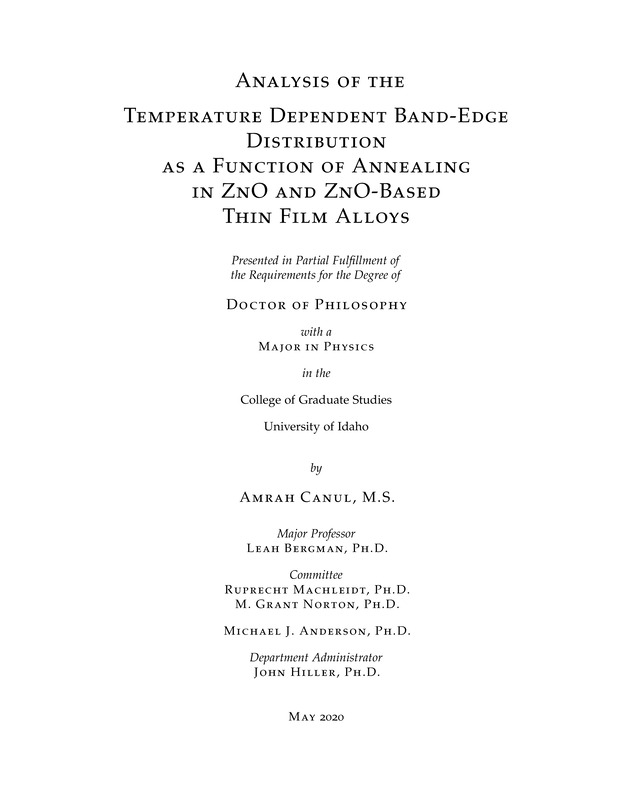Analysis of the Temperature Dependent Band-Edge Distribution as a Function of Annealing in ZnO and Zno-Based Thin Film Alloys
Canul, Amrah. (2020-05). Analysis of the Temperature Dependent Band-Edge Distribution as a Function of Annealing in ZnO and Zno-Based Thin Film Alloys. Theses and Dissertations Collection, University of Idaho Library Digital Collections. https://www.lib.uidaho.edu/digital/etd/items/canul_idaho_0089e_11853.html
- Title:
- Analysis of the Temperature Dependent Band-Edge Distribution as a Function of Annealing in ZnO and Zno-Based Thin Film Alloys
- Author:
- Canul, Amrah
- Date:
- 2020-05
- Program:
- Physics
- Subject Category:
- Physics
- Abstract:
-
The study of the band edge in UV-Vis absorption spectra has impacted fundamental understanding of semiconductor physics as well as advances in technological application. An analytical approach based on the derivative of the absorption spectra was used to explore the nature of the band-edge of ZnO and MgZnO thin films grown via the sputtering technique. It was found that the band-edge is composed of a Gaussian where the width and peak position were employed to model the electron-phonon (e-p) interaction and defect characteristics of the film. These characteristics were studied via transmission experiments in the temperature range of 77 K to 532 K. The as-grown film was found to exhibit a very weak e-p coupling relative to the static contribution of defects similar to the behavior of amorphous-like semiconductors. Upon successive controlled annealing of the ZnO film, up to 800 C, the defect component diminished and the phonon contribution became dominant. Specifically, the e-p interaction was similar to semiconductors with long range order. X-ray diffraction and imaging studies agree with these results. The defects in the ZnO films are discussed in terms of structural inhomogeneities and Zn interstitials prevalent in ZnO films grown via sputtering. MgZnO showed similar defect and e-p coupling behavior. Furthermore, building on the derivative analysis, we show an analytical technique capable of separating signal-artifact convolution. Finally, we develop an analytic set of models that can be applied to nonlinear band-edges. We show that, in the limiting case of linearity, our model is consistent with and produces the same results as the linear Urbach model. Our new model is capable of bypassing “tailing” as an indirect measure of the spread in the local potential and gives a direct measure of this quantity.
The author gratefully acknowledges the U.S. Department of Energy, Office of Basic Energy Sciences, Division of Materials Science and Engineering, Award No. DE-FG02-07ER46386
- Description:
- doctoral, Ph.D., Physics -- University of Idaho - College of Graduate Studies, 2020-05
- Major Professor:
- Bergman, Leah
- Defense Date:
- 2020-05
- Identifier:
- Canul_idaho_0089E_11853
- Type:
- Text
- Format Original:
- Format:
- application/pdf
- Rights:
- In Copyright - Educational Use Permitted. For more information, please contact University of Idaho Library Special Collections and Archives Department at libspec@uidaho.edu.
- Standardized Rights:
- http://rightsstatements.org/vocab/InC-EDU/1.0/

